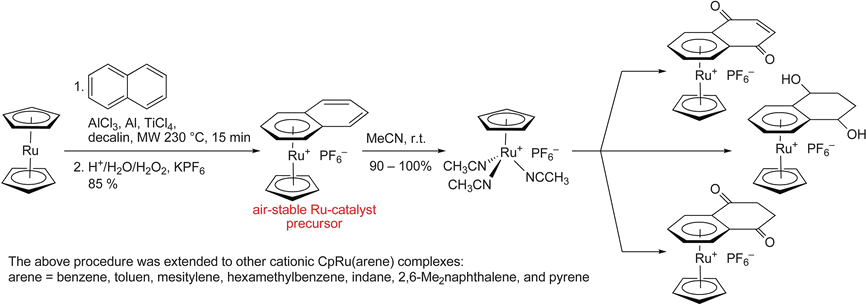- Microwave-Assisted Synthesis and Transformations of Cationic CpRu(II)(naphthalene) and CpRu(II)(naphthoquinone) Complexes
Bocekova-Gajdošíkova, E.; Epik, B.; Chou, J.; Akiyama, K.; Fukui, N.; Guénée, L.; Kündig, E. P.
Helv. Chim. Acta 2019, 102, e190076

Details of the direct synthesis of cationic Ru(II)(η5-Cp)(η6-arene) complexes from ruthenocene using microwave heating are reported. Developed for the important catalyst precursor [Ru(II)(η5-Cp)(η6-1-4,4a,8a-naphthalene)][PF6] reaction time could be shortened from three days to 15-min. The method was extended to [Ru(II)(η6-benzene)(η5-Cp)][PF6], [Ru(II)(η5-Cp)(η6-toluene)][PF6], [Ru(II)(η5-Cp)(η6-mesitylene)][PF6], [Ru(II)(η5-Cp)(η6-hexamethylbenzene)][PF6], [Ru(II)(η5Cp)(η6-indane)][PF6], [Ru(II)(η5-Cp)(η6-2,6-dimethylnaphthalene)][PF6], and [Ru(II)(η5-Cp)(η6-pyrene)][PF6]. 1-methylnaphthalene and 2,3-dimethylnaphthalene afforded mixtures of regioisomeric complexes. [Ru(Cp)(CH3CN)3][PF6], derived from the naphthalene precursor provided access to the cationic RuCp complexes of naphthoquinone, tetralindione, 1,4-dihydroxynaphthalene, and 1,4-dimethoxynaphthalene. Reduction of the tetralindione complex afforded selectively the endo,endo diol derivative. X-Ray structures of five complexes are reported.
DOI : 10.1002/hlca.201900076
archive ouverte unige:117749
